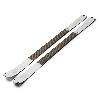Cjanevate 150 and Arrampicarnia 2018, the great climbing meeting in the Carnic Alps

 1 / 19
1 / 19 Arrampicarnia
Arrampicarnia
Three days, two events, one base camp. This is the formula of the climbing festival that will take place from 13 to 15 July in Friuli Venezia Giulia, in the heart of the Carnic Alps, to celebrate the 150th anniversary of the first ascent of Crete delle Chianevate and also to relaunch "Arrampicarnia", the famous non-competitive sports climbing get-together that dates back to the 1980’s. The event takes place at Passo di Monte Croce Carnico, Plöckenpass in German, the alpine pass between Italy and Austria where a symbolic base camp will be established that will host the presentations, historical-cultural meetings, fun and games as well as the local dishes.
The event organisers - a cross-border group that includes the Ravascletto Italian Alpine Club sector, the Paluzza comune, the Paluzza climbing club and the Obergail-Lesachtal Alpenverein - have devised a rich and varied program in order to pay homage to this impressive mountain. Perhaps better known as Cjanevate from the local Friulian dialect (a term that derogatorily means cellar, due to the narrow, flat valley at the base of the south wall), Creta delle Chianevate, Kellerspitzen in German, is a 2769 m high limestone massif clearly visible and recognisable from the Friulian plains.
On 15 July 1868 Paul Grohmann, the great Viennese explorer of the Dolomites, set off from the Eiskar glacier on the steep north face together with the guides Joseph Moser and Peter Salcher and managed to reach the ridge and west summit.
Ever since that first ascent many mountaineers have followed in Grohmann’s footsteps and climbed Creta delle Chianevate, reaching its summit from every aspect via a series of different routes and increasing difficulties. From Julius Kugy to Ettore Castiglioni and Toni Egger, to today’s most talented alpinists from the Friuli and Carinthia regions such as Mazzilis, Ranner, Sterni, Florit and Simonitti.
A series of events will celebrate the history and climbers who carried out the ascents from the mid 19th century to present day. One of these is Pietro Samassa, a multifaceted character and mountain guide from Collina with whom Julius Kugy climbed the SE and NW Face at the beginning of the twentieth century; Enrico Agostinis will celebrates these achievements with an exhibition and a conference. More modern ascents will be remembered, too, such as those carried out by Roberto Mazzilis and Reinhard Ranner who, together with Attilio De Rovere, will talk about "their" Cjanevate.
The festivities are not only in the form of words and images, but naturally also up on the mountain, with guided tours along the battle lines of the First World War and climbs to Creta delle Chianevate and to nearby Creta di Collina with local mountain guides.
While Cjanevate takes the centre stage of the historical-mountaineering program, the sports aspect will be duly celebrated on the southern slopes of Pal Piccolo, on the other side, towards the east, of Passo di Monte Croce Carnico. Arrampicarnia, one of the first non-competitive sport climbing meetings in Italy, took place here in 1986 and this event captured is fondly remembered by many as it captured a specific moment in the embryonic days of this new sport. Some of the most famous climbers of that era took part in the event, including Manolo, Heinz Mariacher, Beat Kammerlander, Mauro Corona, Patrick Berhault, Luisa Iovane, Alessandro Gogna, Icio Dall'Omo, Roberto Mazzilis, Roberto Bassi, Sandro Neri and Pietro Dal Pra; it was an opportunity to climb and celebrate together without points and official rankings. The organisers of Arrampicarnia 2018 wish that this traditional spirit will be passed on to the new generations and that, with this first new edition, the local territory will be revived once again.
Surrounded by lush green alpine meadows and imposing rocky peaks as well as the trenches and fortifications of First World War, the Pal Piccolo crags are actually experiencing a period of renewed interest, thanks also to the help of a new generation of climbers who have bolted a multitude of difficult new routes that have attracted the likes of great climbers such as Adam Ondra, Silvio Reffo and Jacopo Larcher, to name just a few. At present there are a dozen sectors and over 200 routes of all different grades, lengths and angles. The climbing varies from compact slabs to vertical faces and steep overhangs, past cracks and corners up to 9a. There is somethings for everyone, from experts to children and absolute beginners.
Cjanevate 150 and Arrampicarnia 2018, designed to celebrate events and climbers from the past, provide the opportunity to meet others, celebrate and look towards the future, while enjoying the beauty and extraordinary potential of these mountains and the Carnia region.
by Giuliana Tonut
Find out more on www.arrampicarnia.it, Facebook Arrampicarnia
DEUTSCHE VERSION
Drei Tage, zwei Ereignisse, ein Basislager. Das ist die Formel für ein Bergfestival, das vom 13. bis 15. Juli in Friaul-Julisch Venetien, im Herzen der Karnischen Alpen, stattfindet, um den 150. Jahrestag der Erstbesteigung der Kellerspitzen zu feiern und "Arrampicarnia", das berühmte Treffen des nicht-kompetitiven Sportkletterns der achtziger Jahre, neu zu starten. Treffpunkt ist der Plöckenpass, der Alpenpass zwischen Italien und Österreich, wo ein Basislager für Präsentationen, historische und kulturelle Begegnungen sowie Momente der Unterhaltung und Geselligkeit mit lokalen gastronomischen Spezialitäten eingerichtet wird.
Ein reichhaltiges und abwechslungsreiches Programm wurde von den Organisatoren konzipiert, um diesen imposanten Bergen zu huldigen. In der grenzüberschreitenden Organisationsgruppe mit dabei: der CAI Ravascletto, die Gemeinde Paluzza, Climbing Paluzza und der Alpenverein Obergail-Lesachtal. Unter seiner friulanischen Bezeichnung Cjanevate (ein Begriff, der in abschätziger Weise - wegen des vertieften und flachen Tals am Fuße der Südwand - den Keller bezeichnet) wohl am besten bekannt, sind die Kellerspitzen ein 2.769 m hohes Kalksteinmassiv, das von der friulanischen Ebene aus gut sichtbar ist.
Es war der 15. Juli 1868, an dem dem Wiener Paul Grohmann, einem großer Entdecker der Dolomiten, die Erstbesteigung gelang. Mit den beiden Führern Joseph Moser und Peter Salcher erreichte er vom Eiskargletscher aus den Grat und den Westgipfel. Nach Grohmann folgten viele Alpinisten, die auf unterschiedlichsten Routen die Kellerspitzen bezwungen haben. Von Julius Kugy über Ettore Castiglioni und Toni Egger bis hin zu den stärksten Bergsteigern Friauls und Kärntens wie Mazzilis, Ranner, Sterni, Florit und Simonitti.
Mehrere Programmpunkte werden sich mit der Geschichte des Kletterns vom 19. Jahrhundert bis heute beschäftigen. Darunter auch die Geschichte von Pietro Samassa, einer vielseitigen Persönlichkeit und seines Zeichens Bergführer aus Collina, mit dem Kugy Anfang des 20. Jahrhunderts die Südost- und Nordwestflanke bestieg. Ihm zu Ehren gibt es eine eigene Ausstellung und eine von Enrico Agostinis kuratierte Konferenz. Die zeitgenössischen Erinnerungen decken Roberto Mazzilis und Reinhard Ranner ab, die zusammen mit Attilio De Rovere von "ihren Kellerspitzen" erzählen werden.
Neben Wort und Bild gibt es ausreichend Raum für Feste in großer Höhe, mit geführten Ausflügen zu den Stellungen des Ersten Weltkrieges und geführten Touren auf die Kellerspitzen und den Kollin.
Während die Kellerspitzen der Protagonist des historisch-alpinistischen Programms sein werden, werden die südlichen Hänge des Kleinen Pal für die sportlichere Komponente sorgen. Auf der östlichen Seite des Plöckenpasses gelegen, fand hier 1986 die erste "Arrampicarnia" statt, eine der ersten nicht-kompetitiven Sportkletternveranstaltungen Italiens überhaupt. Bis heute in bester Erinnerung sind die Geschichten einer Displin, die damals noch in den Kinderschuhen steckte. Manolo, Heinz Mariacher, Beat Kammerlander, Mauro Corona, Patrick Berault, Luisa Iovane, Alessandro Gogna, Icio Dall'Omo, Roberto Mazzilis, Roberto Bassi, Sandro Neri, Pietro Dal Pra sind einige der berühmten Bergsteiger, die damals an dem Treffen teilgenommen haben. Eine wunderbare Gelegenheit ohne Punkt- und Platzierungszwang zu klettern und gemeinsam zu feiern. Dies ist der traditionelle Geist von "Arrampicarnia", den die Veranstalter der Ausgabe 2018 wieder aufleben lassen wollen.
Das Felswände des Kleine Pal, umgeben von grünen Weiden und imposanten Gipfeln, inmitten historischer Wege und Befestigungen aus der Zeit des Ersten Weltkriegs, erleben in der Tat ein Revival. Es ist eine ambitionierte Gruppe von begeisterten jungen Menschen, die neue Routen aller Schwierigkeitsgrade realisiert haben, welche von den Protagonisten des modernen Kletterns bereits erkundet wurden (unter ihnen Adam Ondra, Silvio Reffo und Jacopo Larcher, um nur einige zu nennen).
Alles in allem ein Gebiet, an das man sich erinnern sollte. Rund zehn Sektoren, über 200 Routen aller Schwierigkeitsgrade, Längen und sehr unterschiedlicher technischer Merkmale. Eine große morophologoische Vielfalt des Felsens, mit kompakten Platten, vertikalen Wänden, Überhängen, Rissen und Verschneidungen. Mit Schwierigkeitsgraden bis zu 9a einerseits für Kletterer attraktiv, andererseits auch für Kinder und Anfänger zugänglich.
"Cjanevate 150 + Arrampicarnia 2018" wurden geschaffen, um Geschichte(n) und Persönlichkeiten der Vergangenheit zu gedenken und diese zu ehren. Daneben bieten die Veranstaltungen Gelegenheit für Begegnungen, um in die Zukunft zu schauen und die Schönheiten und das außergewöhnliche Potential der Karnischen Alpen gemeinsam zu betrachten und zu erarbeiten.
Giuliana Tonut
Das vollständige Programm unter www.arrampicarnia.it, Facebook Arrampicarnia



 Copia link
Copia link



















 See all photos
See all photos























